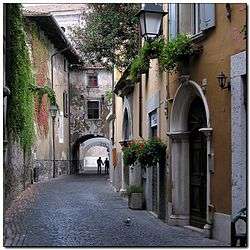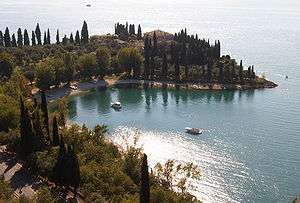Garda, Veneto
| Garda | |
|---|---|
| Comune | |
| Comune di Garda | |
 | |
 Garda Location of Garda in Italy | |
| Coordinates: 45°34′N 10°43′E / 45.567°N 10.717°ECoordinates: 45°34′N 10°43′E / 45.567°N 10.717°E | |
| Country | Italy |
| Region | Veneto |
| Province / Metropolitan city | Verona (VR) |
| Frazioni | - |
| Government | |
| • Mayor | Antonio Pasotti |
| Area | |
| • Total | 16.11 km2 (6.22 sq mi) |
| Elevation | 67 m (220 ft) |
| Population (1 June 2007) | |
| • Total | 3,802 |
| • Density | 240/km2 (610/sq mi) |
| Demonym(s) | Gardesani |
| Time zone | CET (UTC+1) |
| • Summer (DST) | CEST (UTC+2) |
| Postal code | 37016 |
| Dialing code | 045 |
| Patron saint | Assumption of the Virgin Mary |
| Saint day | 15 August |
| Website | Official website |
Garda is a comune on the shore of Lake Garda, in the province of Verona, region of Veneto, Northeastern Italy.
It is one of the more characteristic towns on the east Coast of the homonymous biggest lake in Italy: the Lake of Garda. Garda is only 32 kilometres (20 miles) from the city of Verona, and is one of the smallest towns in the whole province. In 1946 in one of the banks, two golden ingots belonged to the Nazis had been found in a bank in Garda. These ingots came from the treasure hidden in the Marnate's Bunker. [1]
Sights
The historical centre of the town, with narrow streets, is still intact. The main income of the town is tourism.
- Villa degli Albertini (16th century) with its magnolia trees,
- Palazzo dei Capitani: the pale-yellow Captain's Palace built in Venetian Gothic style (14th century)
- Palazzo Carlotti built in Renaissance style
- Santa Maria Assunta: This parish church originally dates from the 6th-7th century, but rebuilt starting in 1530 by Giovanni Matteo Giberti, but construction ceased due to lack of funds, and the church, dedicated to the Assumption of the Virgin Mary, was complete only in 1764. The door portals (1824) are made with white Veronese stone. The interior consists of three aisles. The eastern side rest on six heavy columns, the southern side on four lighter ones. They are all connected by round arches. The statues of Saints Peter and Paul (1886) were made by the Veronese sculptor Righetti. The large 14th-15th century wooden crucifix is a masterwork of the church. Behind the crucifix is the printed edict of Pope Innocent II (November 1138) resolving the allocation of tithes. The side altar of St Anthony of Padua dates from 1720. The altarpiece (1720) was painted by Simone Brentani and the statues in Carrara marble represent San Fabiano and San Sebastiano. The two walnut confessionals (17th century) were carved in the workshop of Andrea Brustolon in Rococo style. The side altar (1648) in the "Capella dei Caduti" contains the wooden statue "Madonna and Child" (Veronese style - 15th century). In the right aisle is located the side altar with the paintings of Saints Luigi Gonzaga and Vincenzo Ferreri by Gaspare Diziani (1764). The baptismal font dates from the 17th century. The main altar dates from mid 16th century and stands in front of the organ (1958). Behind the altar on the wall is an Assumption of Mary (17th century). The two statues of angels in front of the altar were sculpted by Francesco Filippini (1600). The pulpit was made out of briar root and walnut.
- Rocca of Garda: Old castle stands 300 m over the town and offers to visitors wonderful views over the whole lake, over the same rise is located the 15th century Carmelite monastery.
- San Vigilio: The name of the village comes from Saint Vigilius (San Vigilio), the Bishop of Trento from 385 to 402 A.D. It became famous in 1540 when Agostino Brenzoni built his villa within a small park. Many famous people have stayed at the Brenzoni Villa, including Tsar Alexander, the King of Naples, Winston Churchill, Laurence Olivier, King Juan Carlos and the British royal family. The peninsula of San Vigilio, on which the villa formerly stood, was described by Riccardo Bacchelli as "the most radiant, airy place." The villa was built in the 16th century for Count Agostino Brenzoni and the designer was Michele Sammicheli (1484-1559).
Bounding communes
Gallery
 Punta San Vigilio and Baia delle Sirene, Lago di Garda
Punta San Vigilio and Baia delle Sirene, Lago di Garda- Villa degli Albertini
 S. Vigilio church
S. Vigilio church Villa Brenzone - Punta San Vigilio
Villa Brenzone - Punta San Vigilio Villa Brenzone - Punta San Vigilio
Villa Brenzone - Punta San Vigilio Palazzo Fregoso
Palazzo Fregoso
References
- ↑ Goglio, Giuseppe. "MARNATE - Aperto al pubblico il bunker di via Lazzaretto". settenews. Retrieved 24 November 2016.
External links
| Wikimedia Commons has media related to Garda. |
This article is issued from Wikipedia - version of the 11/28/2016. The text is available under the Creative Commons Attribution/Share Alike but additional terms may apply for the media files.
